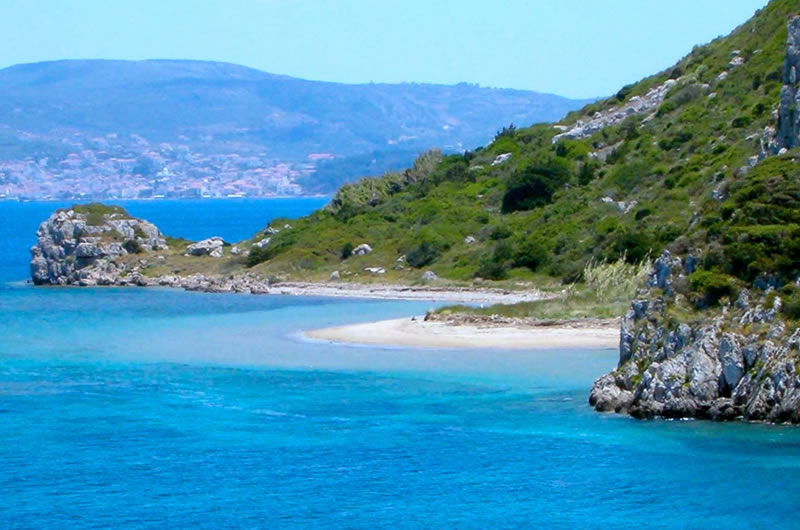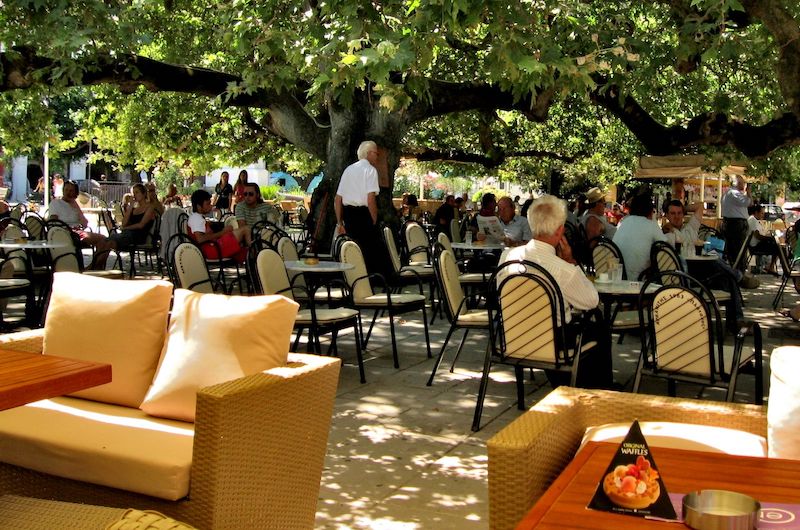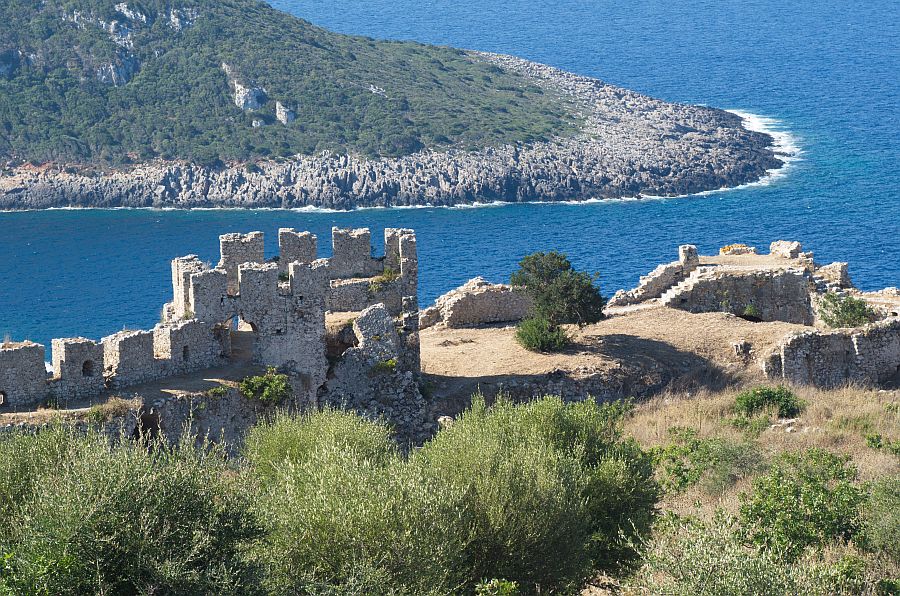Prehistoric Till Now Days
Pylos has evidence of continuous human presence dating back to the Neolithic.
Prehistoric and Mycenaean Pylos
Pylos has evidence of continuous human presence dating back to the Neolithic. In Mycenaean times, it was an important centre often referred to as Nestor's kingdom of "sandy Pylos" and described by Homer in Book 17 of the Odyssey when Telemachus says:
we went to Pylos and to Nestor, the shepherd of the people, and he received me in his lofty house and gave me kindly welcome, as a father might his own son who after a long time had newly come from afar: even so kindly he tended me with his glorious sons.
The Mycenaean state of Pylos (1600–1100 BC) covered an area of 2,000 square kilometres (770 sq mi) and had a minimum population of 50,000 according to the Linear B tablets discovered there, or even perhaps as large as 80,000–120,000. It included the important regional capital of Iklaina (c. 1600–1100 BC).
The Pylos site was excavated by Carl Blegen between 1939 and 1952. It is located at Ano Englianos, about 9 km northeast of the bay. Blegen identified the remains found there as the great "Palace of Nestor" described in the Homeric poems. Linear B tablets found by Blegen clearly demonstrate that the site itself was called Pylos (Pulos in Mycenaean Greek; attested in Linear B as 𐀢𐀫, pu-ro) by its Mycenaean inhabitants. This site was abandoned sometime after the 8th century BC and burned to the ground.
The ruins of a crude stone fortress on nearby Sphacteria, apparently of Mycenaean origin, were used by the Spartans during the Peloponnesian War. (Thucydides iv. 31)

Classical Pylos
It was one of the last places which held out against the Spartans in the Second Messenian War, upon the conclusion of which the inhabitants emigrated to Cyllene, and from thence, with the other Messenians, to Sicily. From that time its name never occurs in history till the seventh year of the Peloponnesian War.
According to the Greek historian Thucydides in his History of the Peloponnesian War, the area was "together with most of the country round, unpopulated". The ancient city was not located at the modern Pylos, but north of the isle of Sphacteria. In 425 BC the Athenian politician Cleon sent an expedition to Pylos where the Athenians fortified the rocky promontory now known as Old Pylos at the northern edge of the bay, near the Gialova Lagoon, and after a conflict with Spartan ships in the Battle of Pylos, seized and occupied the bay. Demosthenes, the Athenian commander, completed the fort in 424 BC.
The erection of this fort led to one of the most memorable events in the Peloponnesian War. Thucydides has given a minute account of the topography of the district, which, though clear and consistent with itself, does not coincide, in all points, with the existing locality, Thucydides describes the harbour, of which the promontory Coryphasium formed the northern termination, as fronted and protected by the island Sphacteria, which stretched along the coast, leaving only two narrow entrances to the harbour,--the one at the northern end, opposite to Coryphasium, being only wide enough to admit two triremes abreast, and the other at the southern end wide enough for eight or nine triremes. The island was about 15 stadia in width, covered with wood, uninhabited and untrodden.
Pausanias also says that the island Sphacteria lies before the harbour of Pylus like Rheneia before the anchorage of Delos. A little later the Athenians captured a number of Spartan troops besieged on the adjacent island of Sphacteria.
Spartan anxiety over the return of the prisoners, who were taken to Athens as hostages, contributed to their acceptance of the Peace of Nicias in 421 BC.

Middle Ages
Little is known of Pylos under Byzantine rule, except for a mention of raids by Saracens in the area c. 872/3.
In 1204, following the Fourth Crusade, the Peloponnese became the Principality of Achaea, a Crusader state. Pylos fell quickly to the Crusaders according to a brief reference in the Chronicle of the Morea, but it is not until the 1280s that it is mentioned again.
The fortress remained relatively unimportant thereafter, except for the naval battle in 1354 between Venice and Genoa.
At about this time, Albanians settled in the area, while in 1381/2, Navarrese, Gascon and Italian mercenaries were active there. From the early years of the 15th century, Venice set its eyes on the fortress of Navarino, fearing lest its rivals the Genoese seize it and use it as a base for attacks against the Venetian outposts of Modon and Coron.
In the event, the Venetians seized the fortress themselves in 1417 and, after prolonged diplomatic manoeuvring, succeeded in legitimizing their new possession in 1423.

First Venetian and first Ottoman periods
In 1423, Navarino, like the rest of the Peloponnese, suffered its first Ottoman raid, led by Turakhan Bey, which was repeated in 1452. It was also at Navarino that Emperor John VIII Palaiologos embarked in 1437, heading for the Council of Ferrara, and where the last Despot of the Morea, Thomas Palaiologos, embarked with his family in 1460, following the Ottoman conquest of the Despotate of the Morea. After 1460, the fortress, along with the other Venetian outposts and Monemvasia and the Mani Peninsula, were the only Christian-held areas in the peninsula. Venetian control over Navarino survived the First Ottoman–Venetian War (1463–79), but not the Second (1499–1503): following the Venetian defeat in the Battle of Modon in August 1500, the 3,000-strong garrison surrendered, although it was well provisioned for a siege. The Venetians recaptured it shortly after, on 3/4 December, but on 20 May 1501, a joint Ottoman land and sea attack under Kemal Reis and Hadım Ali Pasha retook it.
The Ottomans used Navarino (which they called Anavarin or Avarna) as a naval base, either for piratical raids or for major fleet operations in the Ionian and Adriatic seas. In 1572/3, the Ottoman chief admiral built a new fortress at Navarino Neokastro, to replace the outdated Frankish castle.
The Venetians briefly captured Navarino in the 1650s during the Cretan War.
In 1668, Evliya Çelebi described the city in his Seyahatname:
Anavarin-i Atik is an unequalled castle... the harbor is a safe anchorage...
in most streets of Anavarin-i Cedid there are many fountains of running water... The city is embellished with trees and vines so that the sun does not beat into the fine marketplace at all, and all the city notables sit here, playing backgammon, chess, various kinds of draughts, and other board games....

Second Venetian period, Ottoman reconquest and Greek Independence
In 1685, during the early stages of the Morean War, the Venetians under Francesco Morosini and Otto Wilhelm Königsmarck invaded the Peloponnese and captured most of it, successfully storming the two fortresses of Navarino in the process. With the peninsula safely in Venetian hands, Navarino became an administrative centre in the new "Kingdom of the Morea", as the Venetian province was called, until 1715, when the Ottomans recovered the Peloponnese. The Venetian census of 1689 gave the population as 1,413, while twenty years later it had risen to 1,797 inhabitants.
On 10 April 1770, after a six-day siege, the fortress of New Navarino surrendered to the Russians during the Orlov Revolt. The Ottoman garrison was allowed to depart for Crete, while the Russians repaired the fortress to make it their base. On 1 June, however, the Russians left, and the Ottomans re-entered the fort and burned and partially demolished it.
Meanwhile, the population gathered there had escaped to nearby Sphacteria, where Albanian mercenaries of the Ottomans slaughtered most of them.
After the outbreak of the Greek War of Independence in mid-March 1821, Navarino was besieged by the local Greeks on 29 March. The garrison, augmented by the local Muslim population of Kyparissia, held out until the first week of August, when they were forced to capitulate. Despite their promise for safe conduct, the Greeks massacred them all.
The Turks under Ibrahim Pasha of Egypt retook most of the Peloponnese in 1825, including the Pylos area, overcoming the Greek defenders at the battles of Sphacteria (29 April) and Neokastro (11 May). The fortress remained in Ottoman hands until the spring 1828, but in October 1827, the combined Ottoman–Egyptian fleets were defeated in the bay at the Battle of Navarino by the allied navies of the United Kingdom, France and Russia. This event negated Ibrahim's successes, and in autumn 1828 his troops withdrew from the Peloponnese.

Modern Town
Pylos is a small picturesque seaside town, located in the southwest of Messinia. It is 52 km from the city of Kalamata and has about 2.500 residents. Pylos is built amphitheatrically in the southern opening of the bay of Navarino, where the historic battle took place, and is defined by the Isle Sfaktiria.
Is the largest natural harbor in Peloponnese and simultaneously one of the most interesting tourist destinations of Messinia, thanks to the glorious history and rich natural beauty of the area.
The town of Pylos reminds island due to the particular architecture and color of its houses. Pylos each summer attracts many tourists who visit it to admire its historical monuments and the picturesque landscape.
From Pylos comes Kostis Tsiklitiras, the famous Olympic champion in the high jump at the Olympic Games in Stockholm in 1912. His house still exists, and recently restored by the Municipality of Pylos, to serve as a cultural center, which will house the library-gallery of the municipality.
In Pylos there are many historical and natural attractions. Among them, Paleokastro, Niokastro, the cave of Nestor, the lagoon of Gialova, the area of Voidokilia etc. Furthermore, the impressive ancient trees that dominate the Square of Trion Navarchon, downtown, combined with the breathtaking views of Sfaktiria Island create a separate idyllic atmosphere.
Pylos is a beautiful city for quiet summer vacation, since apart from the interesting sights has also wonderful beaches. Enjoy the sun and sea, choosing from sandy or pebble beaches, isolated or crowded and practice water sports in the blue Ionian Sea.
In addition to other features Pylos has a remarkable tourist infrastructure. A wide range of hotels and apartments for every taste are at your disposal, offering you a pleasant and comfortable stay. There are also many restaurants and taverns where you can enjoy among other, fresh fish and delicacies of the traditional Messinian cuisine.
Pylos with the glorious past, the genuine beauty and the warm hospitality of its inhabitants, is waiting for you, and promises to give you unforgettable experiences.





















